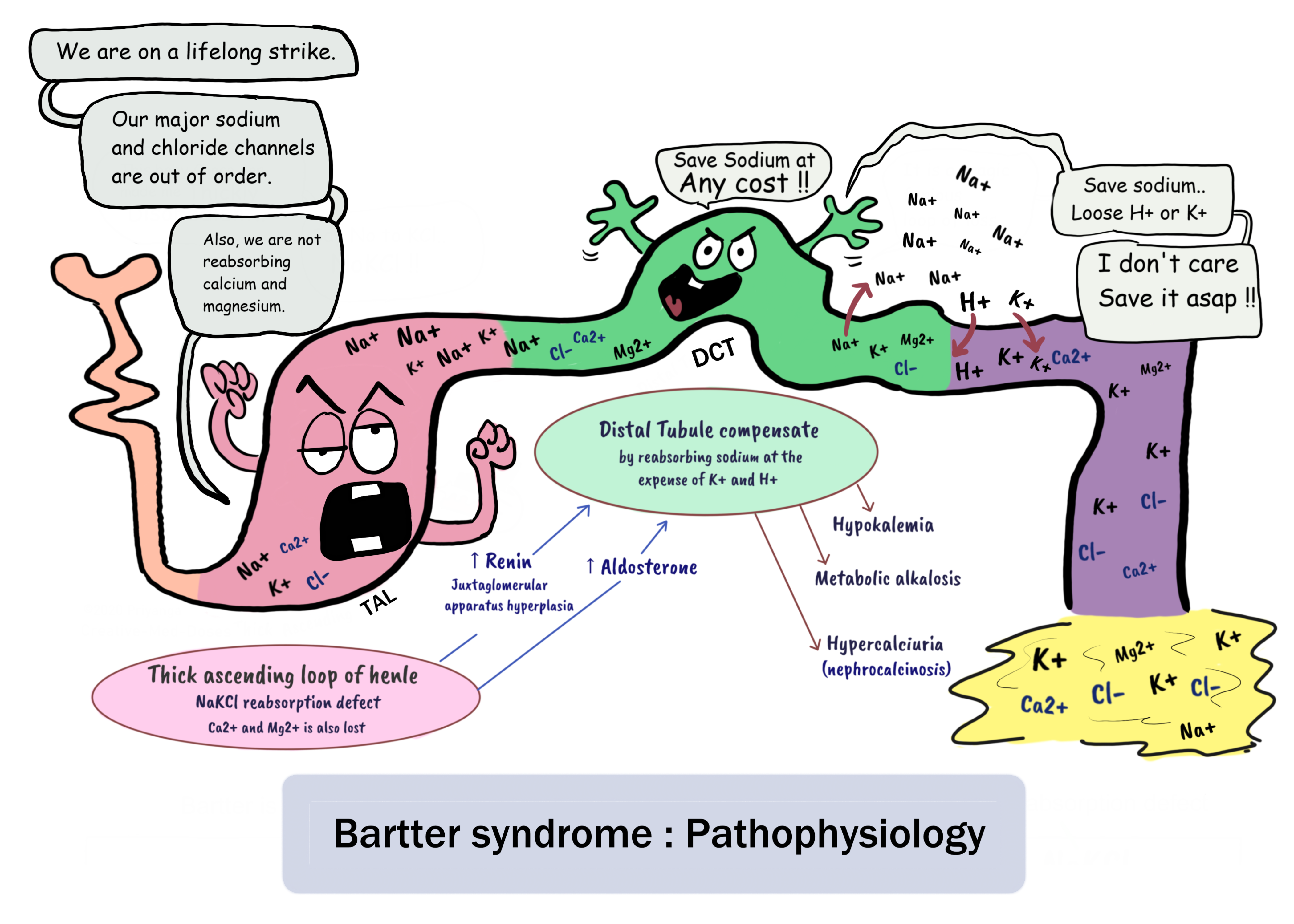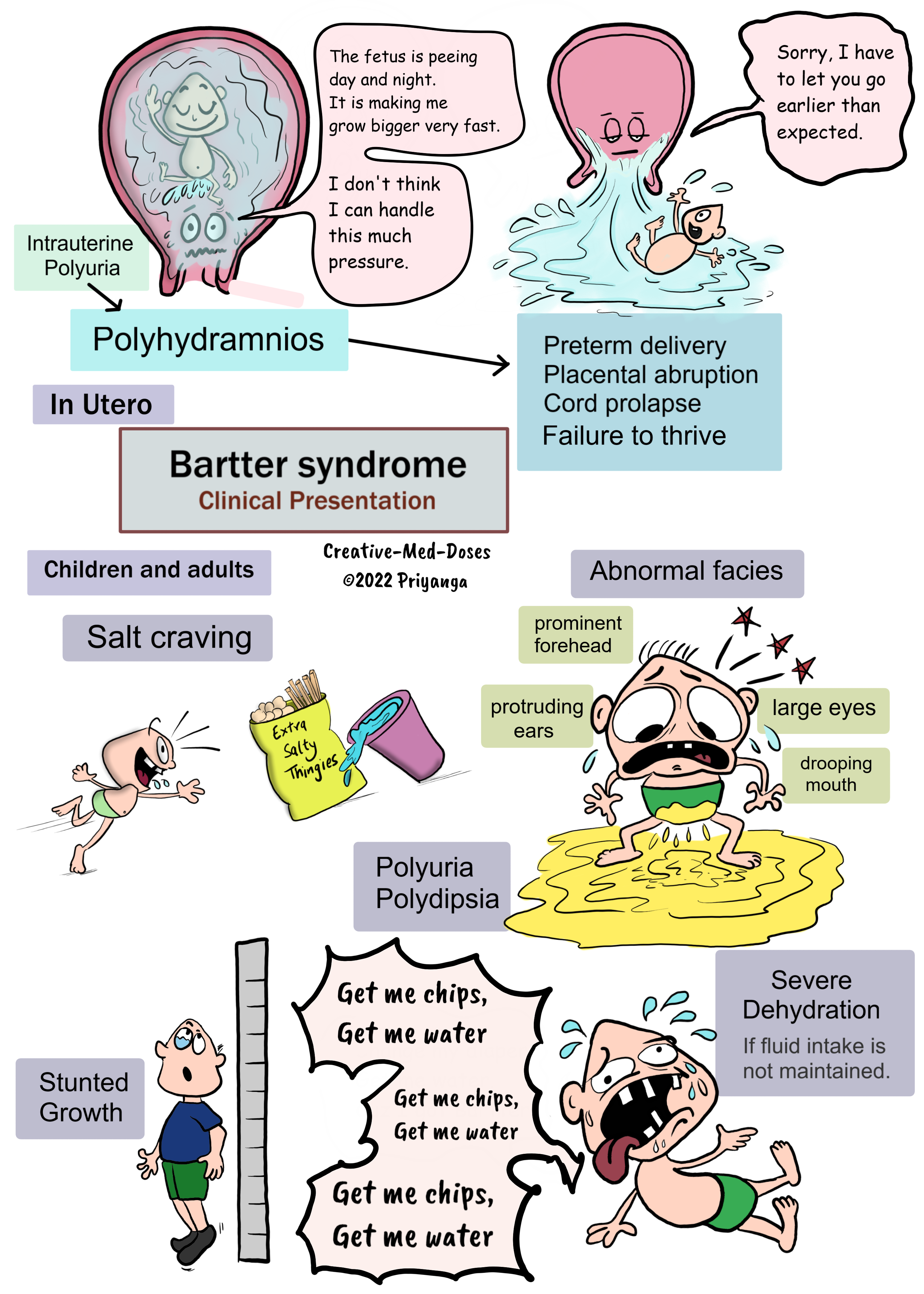Bartter syndrome
Bartter syndrome is an autosomal recessive salt-wasting renal tubular disorder. It is characterized by hypokalemia, hypochloremia, metabolic alkalosis, and high renin with normal/low blood pressure. This disorder mimics chronic loop diuretic (furosemide).
It results from mutations in various genes that affect the function of ion channels and transporters that mediate transepithelial salt reabsorption in the thick ascending limb of the loop of Henle.
Etiology
Impairment in the sodium-potassium-chloride cotransporter (NKCC2) or the potassium channel (ROMK) affects the transport of sodium, potassium, and chloride in the thick ascending limb of the loop of Henle (TALH) and leads to Bartter syndrome.
Types of Bartter syndrome:
- Type I results from mutations in the sodium chloride/potassium chloride cotransporter gene (NKCC2)
- Type II results from mutations in the ROMK gene.
- Type III results from mutations in the chloride channel gene (CLC-Kb)
- Type IV results from the loss-of-function mutations in gene encoding barttin. Barttin is required for both chloride channels ClC-Kb and ClC-Ka to function.
- Type V results from mutations in extracellular calcium ion-sensing receptors and in the genes that encode the chloride channel subunits, ClC-Ka and ClC-Kb.
Pathophysiology
Bartter syndrome is a renal tubular salt-wasting disorder where a mutation in various sodium and chloride transporting channels genes leads to impaired reabsorption of sodium and chloride in the thick ascending limb of the loop of Henle.
Impaired chloride reabsorption in the thick ascending limb of the loop of Henle results in malabsorption of calcium thick ascending limb (TAL). Under normal conditions, calcium and magnesium are absorbed paracellularly under the influence of a positive charge in the lumen due to the reabsorption of negatively charged chloride ions. Increased calcium loss in urine increases the chances of Osteoporosis and Nephrocalcinosis.
Increased Distal convoluted tubular delivery of sodium, calcium, and magnesium → increased renin through JG apparatus →activation of Renin angiotensin aldosterone system →increased sodium reabsorption in DCT in exchange of potassium and hydrogen ions→ hypokalemia and metabolic alkalosis
Excessive salt and water loss →volume depletion →activation of the renin-angiotensin-aldosterone system (RAAS) →secondary hyperaldosteronism →Long-term stimulation causes hyperplasia of the juxtaglomerular apparatus →high renin levels with normal blood pressure
...

...
Clinical Presentation
Signs and symptoms of Bartter syndrome are due to electrolyte imbalance, water loss, and its consequences. It mimics long-term ingestion of loop diuretics (furosemide).
In Utero
- Polyhydramnios
- Cord prolapse
- Preterm delivery
- Placental abruption
Infants
- Polyuria
- Polydipsia
- Severe dehydration
- Failure to thrive
Children and adults
- Salt craving
- Polyuria
- Polydipsia
- Normal to low blood pressure
- Failure to thrive
- Vomiting
- Abnormal facies – prominent forehead, large eyes, protruding ears, drooping mouth
- Sensorineural hearing loss
- Cardiac arrhythmias and sudden cardiac death due to electrolyte imbalances
- Osteoporosis due to calcium loss in urine
...

...
Treatment
- Tubular defects in Bartter syndrome cannot be corrected, Kidney Transplantation is the only cure.
Management goals
- Intermittent amniocentesis (draining excess amniotic fluid) to treat polyhydramnios
- Normalize potassium levels
- Treat metabolic alkalosis
- Treat and prevent dehydration – saline infusion
- Potassium-sparing diuretics (amiloride, spironolactone) blocks distal tubular sodium-potassium/hydrogen ion exchange and treat hypokalemia and metabolic alkalosis
- ACE inhibitors and angiotensin receptor blockers decrease angiotensin and aldosterone effects and limit proteinuria
- Kidney transplantation in end-stage renal disease
Read more books here Books - Creative Med Doses
Revision for today Pulmonary Hypertension - Creative Med Doses